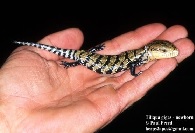Giant Bluetongue Skink (Tiliqua gigas)
Description: Tiliqua gigas has an elongated body and very small limbs, which is typical of most skinks of the genus. They typically get up to 18-24 inches in length and weigh up to 1 kilogram. They are known for their thinner, elongated tails, and avoiding participation in seasonal brumation as they regulate their breeding cycle on a wet and dry season.
T. gigas gigas are the most tropical and known for having the skinniest tail. They have solid, dark, or near solid dark limbs. T. gigas evanescens are easily recognized for having slightly more colored speckling on their limbs, a single, centered stripe on the back of their neck, and not always but most often, having very thin body banding. They also have the longest tail. Tiliqua gigas keyenesis is known for is all-over body speckling, including speckling all over the face.
The Australian Northern Blue Tongue (Tiliqua scincoides intermedia) is recognized as the largest of all the species and subspecies. Not enough studies have been conducted to give that title to either of the Tiliqua gigas species. What is irrefutable, is the Tiliqua gigas evanescens species is the longest of all the blue tongues often reaching lengths that exceed 30 inches from snout to tip of tail.
Habitat: This species is known from a number of habitats from open cleared areas, open grassland, savanna, primary and secondary rainforest, and modified areas such as plantations rural gardens and rural villages. This species is secretive and usually found in and under decaying logs, piles of vegetation, and under sheets of iron. It is occasionally seen basking in the early morning
Range: Found in Floirda in Miami-Dade County.
Found in these States:
FL
Diet: Blue-tongued skinks are omnivorous, eating both animal and plant matter. In the wild, they eat fruit, insects, mollusks and carrion.
Reproduction: Unlike most reptile species, these skinks do not lay eggs. Instead they are ovoviviparous, meaning they give birth to live young encased in membranous sacs. Mating occurs in the spring months. Gestation lasts three to four months and results in five to 15 young. Neonates are able to feed on their own after birth and are reared quickly.
Status: Tiliqua gigas has been assessed as Least Concern owing to its large distribution throughout New Guinea and the Moluccan Islands, and because no major threats are thought to exist.
Subspecies: Three, inconclusive as to which subspecies was introduced into the U.S.
Merauke Blue-tongued Skink - (Tiliqua gigas evanescens)
Halmahera Blue-Tongue Skink - (Tiliqua gigas gigas)
Kei Island Blue-Tongue Skink - (Tiliqua gigas keiensis)
»» Kingdom: Animalia - Animals
»» Phylum: Chordata - Chordates
»» Subphylum: Vertebrata - Vertebrates
»» Class: Reptilia - Reptiles
»» Order: Squamata - Lizards
»» Family: Scincidae - Skinks
»» Genus: Tiliqua
»» Species: Tiliqua gigas - Giant Bluetongue Skink
This article uses material from the Wikipedia article "Tiliqua gigas", which is released under the Creative Commons Attribution-Share-Alike License 3.0. Content may have been omitted from the original, but no content has been changed or extended.
|







